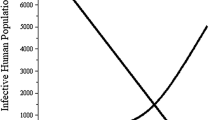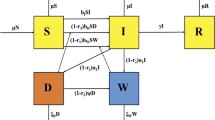Abstract
The improper and poor sanitation, unclean drinking water and lack of hygiene are the key factors that affect the spread of various infectious diseases such as tuberculosis, typhoid fever,and cholera. In this paper, the effect of sanitation effort to control the spread of bacterial diseases is modeled and analyzed. In the modeling process, the total human population in the habitat is divided into two classes of susceptibles and infectives. The disease is assumed to spread directly by contact of susceptibles with infectives and indirectly by bacteria released by infectives in the environment affecting the susceptibles. It is assumed that the bacterial population density is directly proportional to the infective population. To mitigate the bacteria population present in the environment, suitable sanitation effort is applied to keep the environment clean so that the spread of disease could be controlled. The sanitation effort applied is modeled logistically, the intrinsic growth of which is assumed to be directly proportional to the density of bacteria present in the environment. The proposed model is analyzed using the stability theory of differential equations and numerical simulation. The analysis of the model reveals that by increasing the rate of sanitation effort, the bacteria population in the environment declines. This decrease in bacteria population in the environment ultimately decreases the infective population. Thus, the spread of bacterial diseases can be controlled if suitable sanitation effort is applied to curtail the bacterial population in the environment.











Similar content being viewed by others
References
Agarwal M, Verma V (2012) Modeling and analysis of the spread of an infectious disease cholera with environmental fluctuations. Appl Appl Math Int J 7(1):406–425
Anderson R, May R (1979) Population biology of infectious diseases. Part-I. Nature 280:361–367
Baafi J, Darko I, Asenso F (2017) Vaccination as a control of infectious diseases. J Appl Comput Math. https://doi.org/10.4172/2168-9679.1000357
Balamuralitharan S, Radha M (2017) Stability analysis of cholera-carrier dependent infectious disease. In J Pure Appl Math 13(11):234–242
Bhunu C (2011) Mathematical analysis of a three-strain tuberculosis transmission model. Appl Math Model 35(9):4647–4660
Collinson S, Khan K, Heffernan JM (2015) The effects of media reports on disease spread and important public health measurements. PLoS One. https://doi.org/10.1371/journal.pone.0141423
Cui J, Sun Y, Zhu H (2007) The impact of media on the control of infectious diseases. J Dyn Differ Equ. https://doi.org/10.1007/s10884-007-9075-0
Cui J, Wu Z, Zhou X (2014) Mathematical analysis of a cholera model with vaccination. J Appl Math. https://doi.org/10.1155/2014/324767
Dubey B, Dubey P, Dubey US (2015) Role of media and treatment on an sir model. Nonlinear Anal Model Control 21:185–200
Ghosh M, Chandra P, Sinha P, Shukla J (2005) Modelling the spread of bacterial disease: effect of service providers from an environmentally degraded region. Appl Math Comput 60:615–647
Ghosh M, Chandra P, Sinha P, Shukla J (2006) Modelling the spread of bacterial infectious disease with environmental effect in a logistically growing human population. Nonlinear Anal RWA 7:341–363
Gonzalez-Guzmem J (1989) An epidemiological model for direct and indirect transmission of typhoid fever. Math Biosci 96:33–46
Greenhalgh D, Rana S, Samanta S, Sardar T, Bhattacharya S, Chattopadhyay J (2015) Awareness programs control infectious disease—multiple delay induced mathematical model. Appl Math Comput 251:539–563
Hethcote HW (2000) The mathematics of infectious diseases. Soc Ind Appl Math 42(4):599–653
Hsu S, Zee A (2004) Global spread of infectious diseases. J Biol Syst 12:289–300
Keeling M, Danon L (2009) Mathematical modelling of infectious diseases. Br Med Bull 92:33–42
Kiss IZ, Cassell J, Recker M, Simon PL (2010) The impact of information transmission on epidemic outbreaks. Math Biosci 225:1–10
Li Y, Cui J (2009) The effect of constant and pulse vaccination on sis epidemic models incorporating media coverage. Commun Nonlinear Sci Numer Simul 14:2353–2365
Liu W (2013) A sirs epidemic model incorporating media coverage with random perturbation. Abstr Appl Anal. https://doi.org/10.1155/2013/792308
Liu R, Wu J, Zhu H (2007) Media/psychological impact on multiple outbreaks of emerging infectious diseases. Comput Math Methods Med 8(3):153–164
Mara D, Lane J, Scott B, Trouba D (2010) Sanitation and health. PLoS Med. https://doi.org/10.1371/journal.pmed.1000363
Misra A, Sharma A, Shukla JB (2011) Modeling and analysis of effects of awareness programs by media on the spread of infectious diseases. Math Comput Model 53(6):1221–1228
Misra AK, Rai RK, Takeuchi Y (2018) Modeling the control of infectious diseases: effects of TV an social media advertisements. Math Biosci Eng 15(6):1315–1343
Mwasa A, Tchuenche J (2011) Mathematical analysis of a cholera model with public health interventions. Biosystems 105:190–200
Nadjafikhah M, Shagholi S (2017) Mathematical modeling of optimized sirs epidemic model and some dynamical behaviors of the solution. Int J Nonlinear Anal Appl 2:125–134
Naresh R, Pandey S (2009) Modeling the cumulative effect of ecological factors in the habitat on the spread of tuberculosis. Int J Biomath 2(3):339–355
Naresh R, Pandey S (2012) Modeling the effect of environmental factors on the spread of bacterial disease in an economically structured population. Appl Appl Math Int J 7(1):426–454
Naresh R, Pandey S, Misra A (2008) Analysis of vaccination model for carrier dependent infectious disease with environmental effects. Nonlinear Anal Model Control 13(2):331–350
Pawelek KA, Oeldorf-Hirsch A, Rong L (2014) Modeling the impact of Twitter on influenza epidemics. Math Biosci Eng 11(6):1337–1356
Sahu GP, Dhar J (2014) Dynamics of an seqihrs epidemic model with media coverage, quarantine and isolation in a community with pre-existing immunity. J Math Anal Appl 421(2):1651–1672
Samanta S, S Rana AS, Misra A, Chattopadhyay J (2013) Effect of awareness programs by media on the epidemic outbreaks: a mathematical model. Appl Math Comput 219:6965–6977
Sharma A, Mishra A (2014) Modeling the impact of awareness created by media campaigns on vaccination coverage in a variable population. J Biol Syst 22(2):249–270
Shukla JB, Singh V, Misra A (2011) Modeling the spread of an infectious disease with bacteria and carriers in the environment. Nonlinear Anal RWA 12:2541–2551
Siddiqui N (2016) Surge. https://listsurge.com/top-10-countries-poor-sanitation-facilities/. Accessed 24 Apr 2019
Zhao Y, Li M, Yuan S (2017) Analysis of transmission and control of tuberculosis in mainland china, 2005–2016, based on the age-structure mathematical model. Int J Environ Res Public Health. https://doi.org/10.3390/ijerph14101192
Zhou X, Cui J (2011) Modeling and stability analysis for a cholera model with vaccination. Math Methods Appl Sci 34(14):1711–1724
Acknowledgements
This research is financially supported by TEQIP-II, HBTU Kanpur, to one of the authors (Sandhya Rani Verma) in the form of Research cum Teaching Fellowship through letter no. SPFU/TEQIP-II/2015-16/88 dated 23.09.2015.
Author information
Authors and Affiliations
Corresponding author
Additional information
Publisher's Note
Springer Nature remains neutral with regard to jurisdictional claims in published maps and institutional affiliations.
Appendices
Appendix 1
Proof
The general variational matrix M for model system (2) is given as follows:
Let \(M_i\) be the matrix M, evaluated at the equilibria \(E_i\) (\(i=0,1,2\)).
The variational matrix \(M_{0}\) of model (2) corresponding to \(E_{0}(0, \frac{A}{d}, 0, 0)\) is given by
The characteristic polynomial of above matrix is given by
From here, it is seen that equilibrium \(E_0\) is unstable.
The variational matrix \(M_{1}\) of model (2) corresponding to \(E_{1}({\overline{Y}}, {\overline{N}}, {\overline{B}}, 0)\) is given by
The fourth eigen value, i.e, \(((\phi - \phi _{1}) {\overline{B}} + \phi _{\text {s}})\) is always positive (since \(\phi > \phi _{1}\)) showing that equilibrium \(E_1\) is unstable.
The variational matrix \(M_{2}\) of model (2) corresponding to \(E_{2}(0, \frac{A}{d}, 0, \frac{\phi _{\text {s}}}{\phi _0})\) is given by
The characteristic polynomial of above matrix is given by
Using Routh–Hurwitz criteria, we get that \(E_{2}\) is unstable if \(R_{0}> 1\) and stable if \(R_{0}< 1\).
To establish the local stability of endemic equilibrium \(E^*\), we linearize the system using small perturbations y, n, b, \(f_{\text {s}}\) about \(E^*\), defined as follows: Y= y+Y*, N= n+N*, B= b+B* and Fs= fs + Fs*
Consider the following positive definite function:
where \(m_{i}\) (\(i = 0, 1, 2, 3\)) are positive constants. Differentiating the above equation w.r.t ‘t’ and using linearized system of model (2) corresponding to \(E^*\), we get
After choosing \(m_{0} = 1, m_{1} = \frac{\beta Y^* + \lambda B^*}{\alpha }\), \(m_{2} = \frac{\lambda (N^* - Y^*)}{\theta }\) and \(m_{3} = \frac{\lambda \theta _{1} B^* (N^* - Y^*)}{(\phi - \phi _{1}) \theta F_{\text {s}}^*}\), we get \(\frac{{\text {d}}U_{1}}{{\text {d}}t}\) to be negative definite showing that \(U_1\) is a Lyapunov function and hence \(E^*\) is locally asymptotically stable provided condition (13) is satisfied.
Appendix 2
Proof
Consider the following positive definite function, corresponding to the model system (2) about \(E^*\),
where \(m_{i}\) (\(i = 0, 1, 2, 3\)) are positive constants.
Differentiating the above equation w.r.t ‘t’ and using (2), we get
After choosing \(m_{0} = 1, m_{1} = \dfrac{\beta Y^* + \lambda B^*}{\alpha }, m_{2} = \frac{\lambda (Y^* + \frac{ A}{d})}{\theta } and m_{3} = \frac{\theta _1 B^*}{(\phi -\phi _1)} m_2\), we get \(\frac{{\text {d}}U_{2}}{{\text {d}}t}\) to be negative definite showing that \(U_2\) is a Lyapunov function and hence \(E^*\) is nonlinearly asymptotically stable provided conditions (14) is satisfied.
Rights and permissions
About this article
Cite this article
Shukla, J.B., Naresh, R., Verma, S.R. et al. Modeling the effect of sanitation in a human habitat to control the spread of bacterial diseases. Model. Earth Syst. Environ. 6, 39–49 (2020). https://doi.org/10.1007/s40808-019-00653-4
Received:
Accepted:
Published:
Issue Date:
DOI: https://doi.org/10.1007/s40808-019-00653-4




